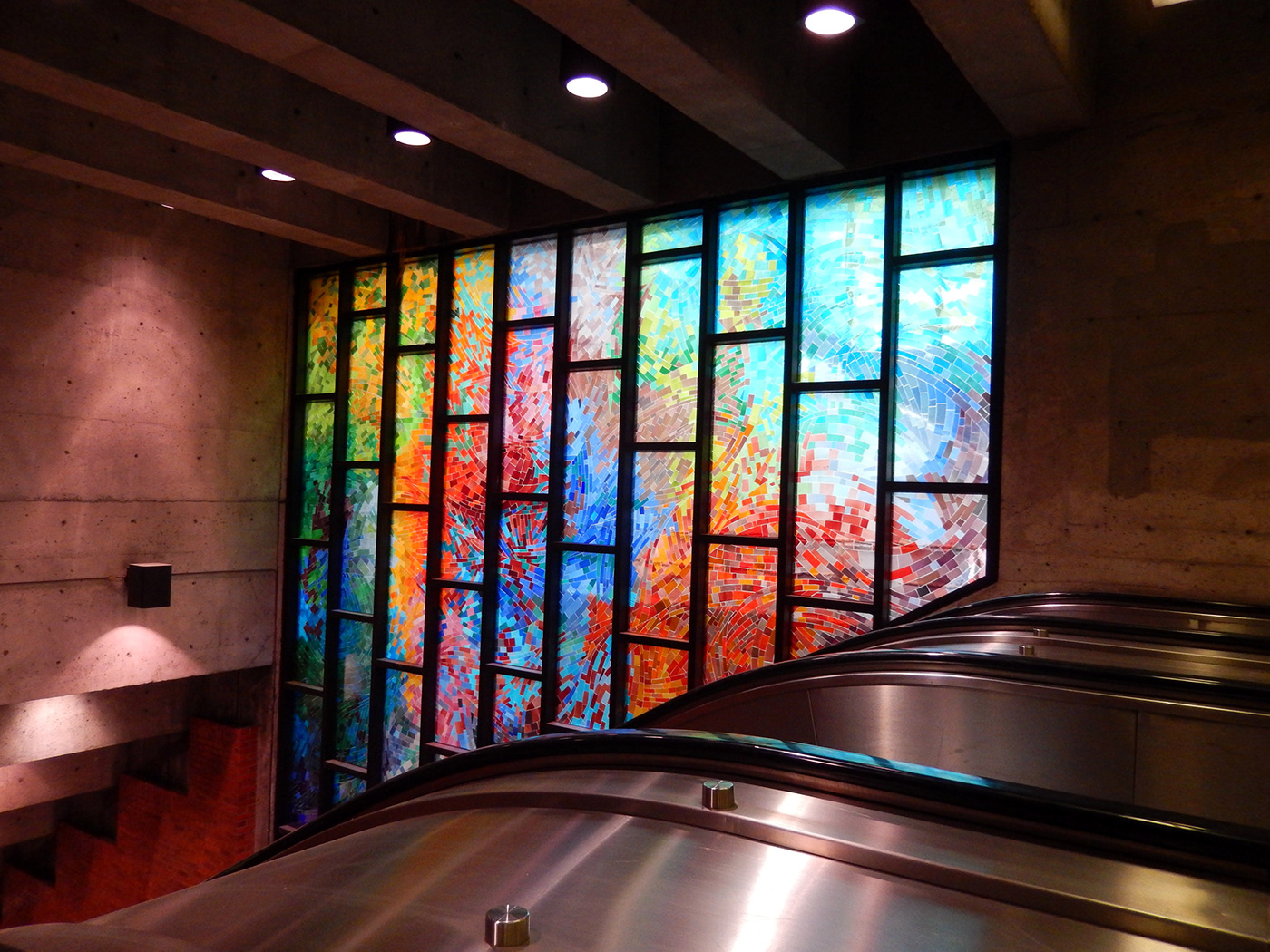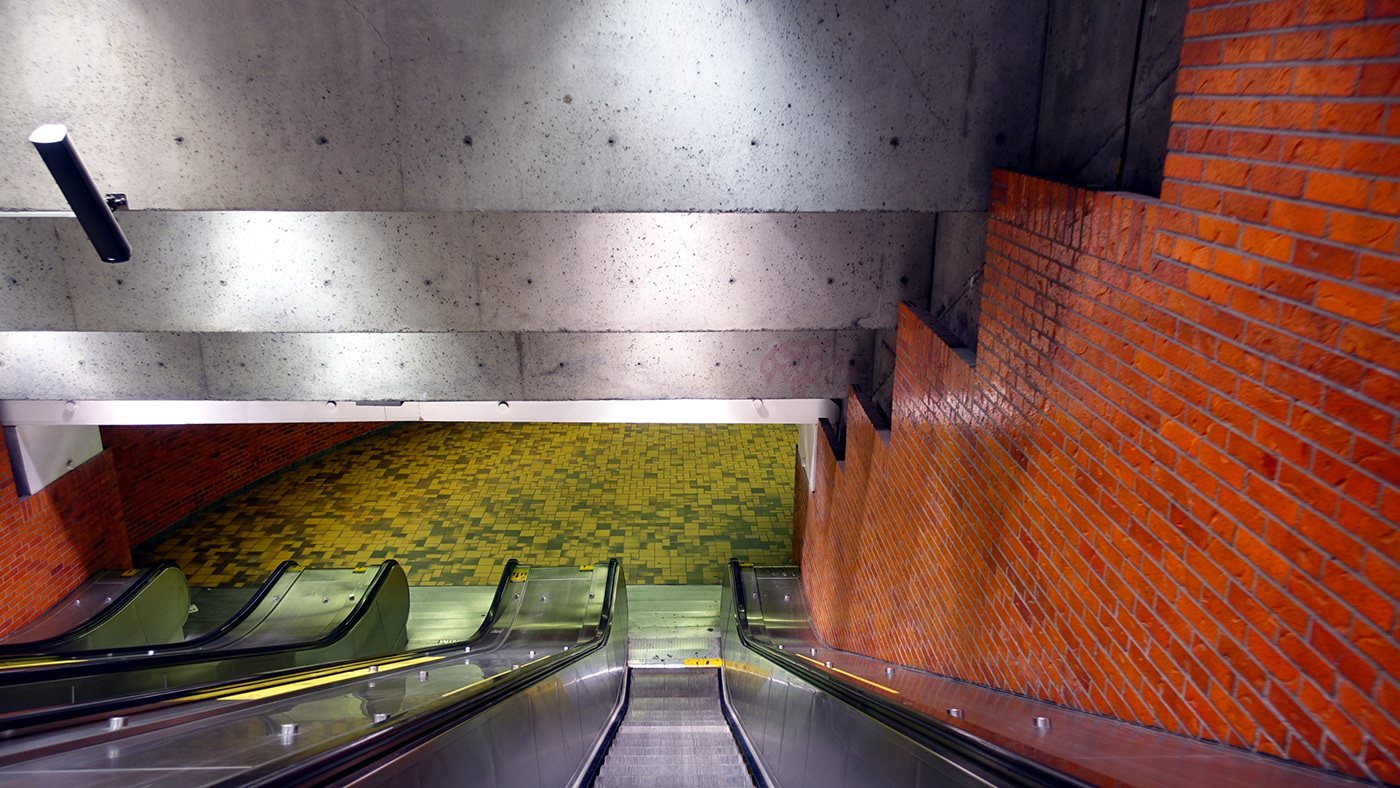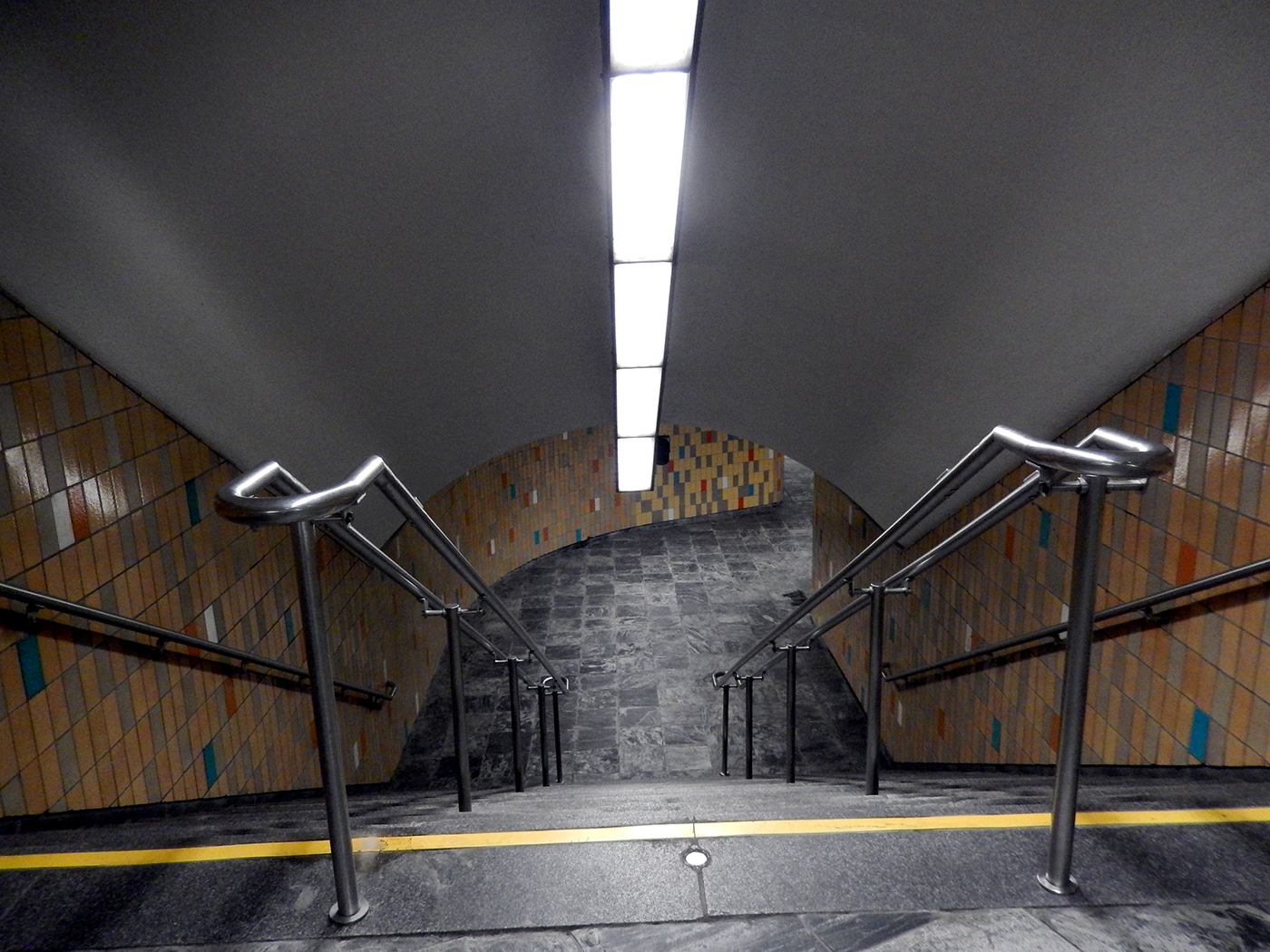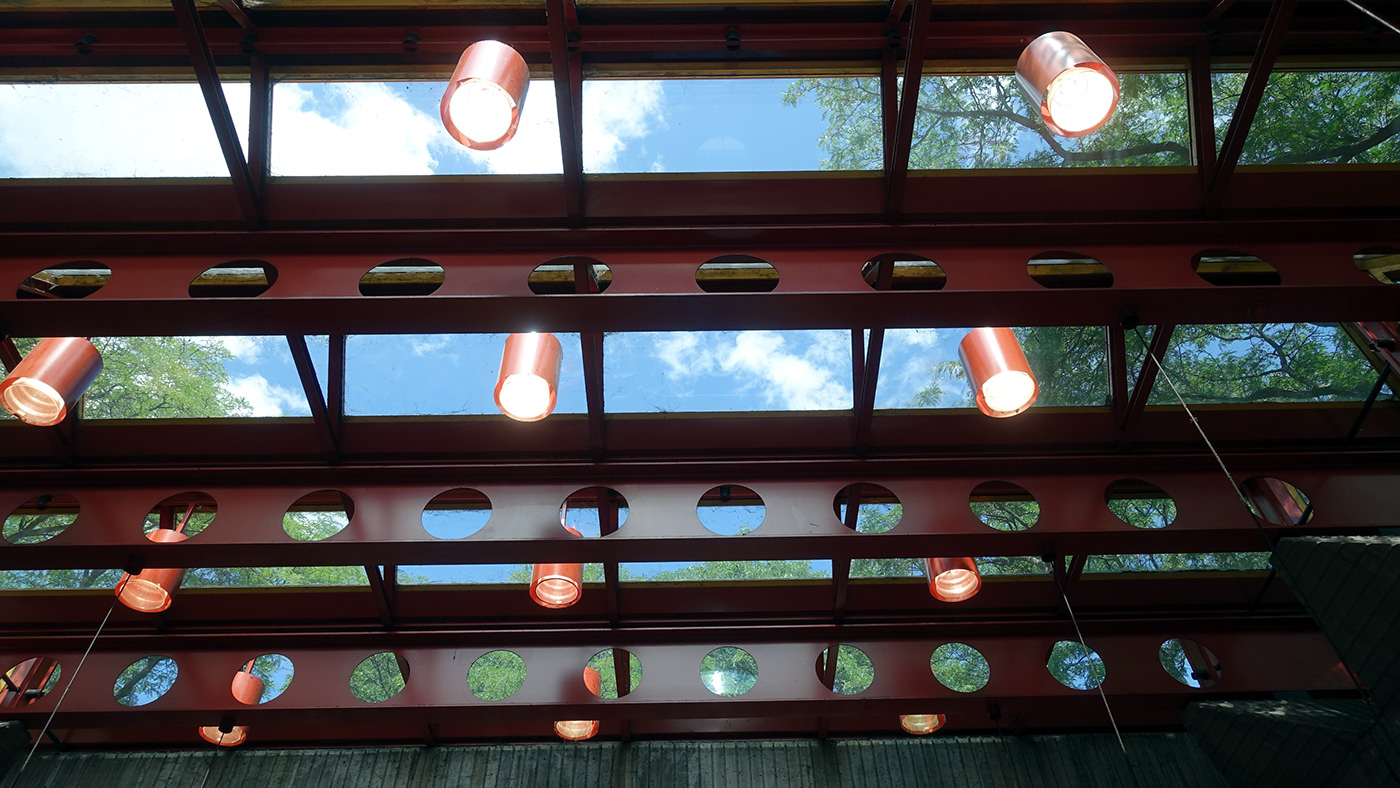
The Green Line - project n° 1
Brief History: "In 1966, the Montreal metro had 26 stations. Since 2007, there are 68. All are
operated by the Société de transport de Montréal, including the station at the city of Longueuil and the three inaugurated at the city of Laval, in 2007.
From the beginning of construction in the early 1960s, the designers of the Montreal metro wanted each station to be unique. So they hired several architects to build the stations. From the 1970s, architects were tasked with integrating art and architecture from a station’s early design stages. Some created the artwork themselves, others commissioned them from artists."
The stations are divided into four lines: the Green Line, the Orange Line, the Blue Line and the Yellow Line. Click on the word Subway to see the network map.
For a month in the summer of 2019, alone I visited all 68 stations. I spent 6-8 hours by day going from one station to another. Going up and down the steps, escalators and elevators. Each time, I looked at the different stations inside and outside, and I took pictures. In all, about 2000 photos.
In total, I show you photos taken at 41 stations. Sometimes just one photo or several.
The length of the Green Line is 22.1 kilometres (13.7 miles) with 27 stations. I show you 12 of them.
My information about the stations has been taken from this link:
and for the artworks to this other:
ANGRIGNON


Opened on September 3, 1978. Angrignon station is located in Le Sud-Ouest borough of Montreal. It is the western terminus of the Green Line. The station includes a large bus terminus for buses to southwest Montreal, the West Island (Dorval), and South Western Quebec.
Angrignon station is built with windows encasing the tracks and side platforms, which creates a very light and airy environment. Jean-Louis Beaulieu received an award from the Québec Association Of Architects for the design of the station.
The station is equipped with the MétroVision information screens which displays news, commercials, and the time till the next train. (Angrignon Wikipedia)

Born in Saint-André-de-Kamouraska in 1943, architect Jean-Louis Beaulieu has never hesitated to create audacious, innovative designs. In addition to station Angrignon and station Snowdon, Jean-Louis Beaulieu also designed the métro’s major repairs workshop on boulevard Saint-Laurent.



LASALLE

LaSalle station is in the borough of Verdun, in Montreal. This station serves the Green Line. The station opened on September 3, 1978.
Designed by Didier, Gillon et Larouche, it is a normal side platform station with one ticket hall and access. The platform and mezzanine walls are enlivened by large, irregular concrete planes painted in bright colours, designed by Michèle Tremblay-Gillon, while a stainless-steel mural by Peter Gnass above the ticket hall reflects sunlight and passengers' movements.
This station is named for nearby LaSalle Boulevard, named for explorer Robert Cavelier de La Salle (1643–1687), who founded the town of Lachine and claimed Louisiana for France.

This mural in stainless steel is a creation by Peter Gnass (1978). Inspired by the sunlight admitted by the clerestory windows overhead, he created this huge, inclined stainless-steel structure, 3.3 metres deep in places.
Born in Rostock, Germany, in 1936, Peter Gnass arrived in Montréal in 1957 and quickly made a name for himself as a sculptor. His works have been featured in several exhibitions and have been integrated into buildings such as Théâtre Maisonneuve at Place des Arts.


CHARLEVOIX

Charlevoix station is in the borough of Le Sud-Ouest in Montreal. This station serves the Green Line and is located in the district of Pointe-Saint-Charles. It opened on September 3, 1978, as part of the extension of the Green Line westward to Angrignon station.
Designed by Ayotte et Bergeron, it was built as a stacked platform station, in order to reduce the width of the station owing to the weak Utica Shale in which it was built. The lower platform is 29.6 m (97 ft 1 in) below the surface, making this the deepest station in the network, as well as the lowest in altitude (the lower platform is below sea level).
This station is named for rue Charlevoix. Pierre François Xavier de Charlevoix (1682–1761) was a French Jesuit historian and explorer of New France. (Charlevoix Wikipedia)


Stained-glass windows (1978) by Marlo Merola & Pierre Osterrath. Location: stairwells.
These two stained-glass windows, chiefly in blue with red and yellow accents, enhance the natural light they admit into this deep station. They were created by Mario Merola, who called on Pierre Osterrath to bring them to life.
This huge jigsaw puzzle of more than 15,000 pieces of glass includes no fewer than 800 different colours.
Born in Montréal in 1931, Mario Merola is a versatile artist best known for his works integrated into public buildings. Pierre Osterrath was born in Hony, Belgium, in 1939; after emigrating to Québec in 1953, he continued the family profession of glass art.





LIONEL-GROULX

Lionel-Groulx station is located in the borough of Le Sud-Ouest in Montreal. It is a transfer station between the Green Line and Orange Line. This station is one of the busiest in the network.
The station opened on September 3, 1978 as part of the extension of the Green Line to Angrignon, with service on the Green Line only. It was therefore the first transfer station to open after Berri-UQAM, in the original network.
In 2009 it became the first existing station to be retrofitted to be fully wheelchair-accessible through the addition of elevators. Berri-UQAM station had elevators added at the same time, but only between the mezzanine and Orange Line platforms.
This station is named to commemorate Lionel Groulx, one of Quebec's most influential historians.
(Lionel-Groulx Wikipedia)


"The Tree of Life." Sculpture on secular walnut tree by Joseph Rifesser (1978).
A ringing call for mutual understanding, this work represents the people of the five continents springing from a common root. Created for Expo 67, it stood in front of the United Nations pavilion and was moved to the métro ten years later. Gift of the United Nations to the city of Montreal.
According to some sources, this was the most photographed artwork at Expo 67.
Born in Ortisei, Italy, in 1921, Joseph “Peppi” Rifesser followed in his father’s and grandfather’s footsteps as a woodcarver. He has enjoyed great success in Europe with his religious works created in the pure medieval Gothic style.
PEEL

Peel station is located in the borough of Ville-Marie in Montreal and serves the Green Line. The station opened on October 14, 1966, as part of the original network of the Metro.
Designed by Papineau, Gérin-Lajoie, and Leblanc, it is a normal side platform station, built in open-cut under boul. De Maisonneuve. Its mezzanine floats within the open-cut volume, supported by pillars and beams, and contains ticket barriers at either end with the fare-paid zone in the centre.
In total, there are five entrances to the subway and the street entrances are integrated into other buildings.
The station is named for Peel Street, which in turn was named for Sir Robert Peel, British Prime Minister from 1834 to 1835 and again from 1841 to 1846. He is best known for creating London's police department while Home Secretary, thus giving them their nickname of "bobbies."
(Peel Wikipedia)

Circles (1966) in ceramic were created by Jean-Paul Mousseau in collaboration with ceramist Claude Vermette. Location: throughout the station.
A vibrant contrast with the texture of the station’s concrete, circles composed of glazed ceramic tiles create a colourful rhythm through the station. It was thanks to this station’s architects, Papineau, Gérin-Lajoie et LeBlanc, that Peel became the first station in the métro to feature art integrated into its architecture.
Born in Montreal, Jean-Paul Mousseau (1927-1991) was a painter, sculptor, set designer, and interior designer. His works can be found both in the collections of major museums and in numerous public places.
MCGILL

"La vie à Montréal au XIXe siècle" (Life in Montreal in the 19th Century) by Nicolas Sollogoub (1974, painted glass) is a gift from Macdonald Tobacco to the City of Montreal.
This suite of five illuminated murals, each made of hundreds of pieces of painted glass, illustrates aspects of Montréal life from 1800 to 1870. In particular, it features the city’s first mayor, Jacques Viger, and his successor, Peter McGill.
Born in Soissons, France, to Russian parents in 1925, Nicolas Sollogoub came to Québec in the 1950s. Alongside his career as a set decorator at Radio-Canada, he conducted numerous artistic projects including the restoration of the Château Dufresne in Montréal.




McGill station is in the borough of Ville-Marie and serves the Green Line. The station opened on October 14, 1966, as part of the original network of the Metro. It is currently the second busiest station (after Berri-UQAM station) in the network.
Designed by Crevier, Lemieux, Mercier and Caron, it is a normal side platform station built in open cut under boul. De Maisonneuve. With two ticket halls joined by corridors that surround the platforms. The ticket halls are linked to the platforms by four stairways per platform, including the shortest escalators in the network. The station has large pillars, which were originally painted orange, but painted in beer bottle green colour in the late 1990s. In January 2010 the STM repainted the station in its original colours being orange pillars and yellow walls.
McGill is named for McGill University. Founded in 1821 with money and on land bequeathed by Scottish-Canadian businessman James McGill, this is one of Canada's most prestigious institutions of higher education. (McGill Wikipedia)


PLACE-DES-ARTS


"Histoire de la musique à Montréal" (1967) by Frédéric Back is painted glass and wrought iron.
Location: east mezzanine. This mural is an homage to the history of music in Montréal, from the time of Jacques Cartier to the contemporary era.
Location: east mezzanine. This mural is an homage to the history of music in Montréal, from the time of Jacques Cartier to the contemporary era.
This work by Frédéric Back was the first work of art to be installed in the Montréal métro after its inauguration on October 14, 1966.
Born in Sarrbrücken, Germany, illustrator Frédéric Back (1924-2013) is renowned worldwide for his animated films. He has received numerous honours and prizes, including two Oscars: one in 1982 for Crac! and the second in 1987 for L’homme qui plantait des arbres (The Man who Planted Trees).

Place-des-Arts station is located in the borough of Ville-Marie, in Montreal and serves the Green Line. The station opened on October 14, 1966, as part of the original network of the Metro.
Designed by David, Boulva, et Cleve, it is a normal side platform station built in open cut under boul. De Maisonneuve with two ticket halls joined by corridors that surround and overlook the platforms. The eastern mezzanine includes staircases with one-way exit-only turnstiles. The station is joined by underground city to Place des Arts and Université du Québec à Montréal, and has additional four street-level exits.
The station's walls are coved in light-grey bricks in a zig-zag layout.
The station is equipped with the MétroVision information screens which displays news, commercials, and the time until the next train arrives. (Place-des-Arts Wikipedia)




A lawyer, Jean Drapeau ran for mayor of Montreal in 1954 under the banner of the "Ligue d’action civique" (Civic Action League) and he was elected. He is 38 years old. Jean Drapeau was mayor of Montreal for almost 30 years, from 1954 to 1957, and then from 1960 to 1986.
During his time as mayor, he built the Montreal Metro and obtained the holding of Expo 67 on Notre-Dame and Sainte-Hélène islands, which made the city known throughout the world. And the Olympics Games Montreal, in 1976.

This architectural composition made of perforated aluminum panels and ceramic was added to conceal a telecommunications room that had been added over the station’s western tunnel opening. Underneath is an abstract ceramic mosaic created by Saskia Siebrand and installed in 2005. It contains tiles of over 300 colours, all custom hand-glazed.
Mosaika Art & Design is a Montréal firm specializing in the production of fine art mosaics. Founded in 1998 by Kori Smith and Saskia Siebrand, it has created dozens of mosaics, notably for the subway systems of New York and Los Angeles as well as Montréal.
Information: (Place-des-Arts Wikipedia) and Place des Arts - Mosaika Art Design.
PAPINEAU

In the station, there are three murals by illustrator George Juhasz & Jean Cartier (ceramist) in enamelled steel. Entitled "Les Patriotes de 1837–1838" these tell the story of the Patriotes Rebellion and commemorate Louis-Joseph Papineau, the famous son of this station's namesake.
I only photographed this one which is dedicated to Louis-Joseph Papineau.
The murals were produced in Stockholm, Sweden, using a process commonly used in Scandinavia at the time.
Born in Saint-Jean-sur-Richelieu, Jean Cartier (1924-1996) had a brilliant career as a ceramist spanning nearly fifty years. Born in Hungary, George Juhasz (1933-2004) arrived in Canada in 1961; over his career as an illustrator, he has created numerous films, books, and artworks.

Papineau station is located in the borough of Ville-Marie. and serves the Green Line. It opened on October 14, 1966, as part of the original network of the Metro.
Designed by Bolduc et Venne, it is a normal side platform station, built in tunnel. A transept leads to a long set of stairways to the entrance, located in the centre of a public square. The temporary entrance building was recently replaced by a new permanent one, designed by Mario Bibeau.
Papineau takes its name from nearby av. Papineau, named for Joseph Papineau, a notary, surveyor, politician, and defender of the rights of the people and of the French language. His son, Louis-Joseph Papineau, led the Patriotes Rebellion, the Lower Canadian portion of the Rebellions of 1837.
Papineau Wikipedia
PRÉFONTAINE

Préfontaine station is is located in the borough of Mercier-Hochelaga-Maisonneuve and serves the Green Line. It opened on June 6, 1976.
Designed by Henri Brillon, it is a normal side platform station, built partly in tunnel with a large
mezzanine and admitting natural light. On November 8, 2021, elevators have opened to the public.
The station is so named because it is located near Raymond-Préfontaine Park and Préfontaine Street. These were named for Raymond Préfontaine (1850–1905), mayor of the former city of Hochelaga, and subsequently mayor of Montreal (1898–1902). (Préfontaine Wikipedia)


JOLIETTE

Joliette station is located in the borough of Mercier-Hochelaga-Maisonneuve in Montreal and serves the Green Line. The station opened on June 6, 1976.
Designed by architect Marcel Raby, it is a normal side platform station built in tunnel. The walls of the platform have a unique yellow brick facade. Two exits, one on either side of rue Hochelaga. The mezzanine contains a large illuminated mural sculpture by the architect, entitled "Thème des mouvements du soleil" ("theme of the sun's motion").
This station is named for rue Joliette. Barthélémy Joliette (1789–1850) served in the House of Assembly and Legislative Council of Lower Canada; he also founded the village of L'Industrie (later Joliette, Quebec).(Joliette Wikipedia)





"Thème des mouvements du soleil" (1976) is in glass, resin, and stainless steel by Marcel Raby.
These colourful and brightly lit glass designs represent the planets of the solar system, with the Earth appearing in the middle. The mirror-finished steel, reflecting the travellers, represents the unity of the planets and human beings in the universe.
The bottom segment, representing the sun, is an arc with the same radius as the vault of the métro tunnel.
City of Montréal architect Marcel Raby designed two neighbouring stations, Joliette and Pie-IX, on the green line. He made a point of designing the artwork for these stations himself, with the exception of Jordi Bonet’s mural at Pie-IX.

PIE-IX

Pie-IX station is in the borough of Mercier-Hochelaga-Maisonneuve in Montreal and serves the Green Line. The station opened on June 6, 1976, in time for the 1976 Summer Olympics.
Designed by architect Marcel Raby, it is a normal station built in open cut. The centre of the station is taken up with a vast mezzanine bisected by a long ticket barrier. This space allows the station to handle very large crowds from the Olympic Stadium. The mezzanine gives direct underground city access to the Stadium. The station has two exits of its own.
This station is named for Pie-IX Boulevard; this street was named in 1912 for Pope Pius IX (1792–1878), elected Pope in 1846. (Pie-IX Wikipedia)



Above left, this mural is in concrete and aluminum. The psyche, the origin of all life and movement, is personified by the mythological figure at the centre of the work. It expresses in a poetic way the Olympic motto Citius Altius Fortius, Latin for "Faster, higher and stronger."
Born in Barcelona, Spain, the illustrator, painter, and sculptor Jordi Bonet (1932-1979) came to Québec in 1954.

This mural in bronze was designed by Marcel Raby (1976), the station’s architect. It presents the five rings representing the Olympic Games cast in bronze, a symbol of permanence.
Created in 1913 by Pierre de Coubertin, the Olympic symbol represents the unity of the five continents (Africa, America, Asia, Europe, and Oceania).
City of Montréal architect Marcel Raby designed two neighbouring stations, Joliette and Pie-IX, on the green line. He made a point of designing the artwork for these stations himself, with the exception of Jordi Bonet’s mural at Pie-IX.
HONORÉ-BEAUGRAND

Honoré-Beaugrand station is located in the borough of Mercier-Hochelaga-Maisonneuve and is equipped with the MétroVision information screens which displays news, commercials, and the time till the next train.
Designed by Papineau, Gérin-Lajoie, Le Blanc, Edwards, it is a normal side platform station built in open cut. With a vast mezzanine and three exits. The stairs from the mezzanine to the platforms are surmounted ceramic murals, one the reverse of the other, by Jean-Paul Mousseau.
The Honoré-Beaugrand station and street were named in honor of Honoré Beaugrand who was mayor of Montreal from 1885 to 1887. He founded the Montreal newspaper La Patrie in 1879.
(Honoré-Beaugrand Wikipedia)

This ceramic mural was created in 1976 by Jean-Paul Mousseau. The ceramic tiling on the walls over the stairs between the mezzanine and platforms forms two abstract and symmetrical murals. Like a negative image, the blue pattern on the south wall is repeated in red tiles on the north wall.
(I had photographed just this wall. Click on the link to see the other wall.)
Born in Montréal, Jean-Paul Mousseau (1927-1991) was a painter, sculptor, set designer, and interior designer.
Thank you for watching!




